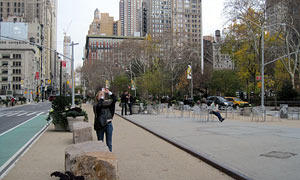Opportunity Knocks
I remember an internship during my college years in the early 1980s in M. Paul Friedberg’s office on the Upper West side of Manhattan. At the end of my first work week, Paul took me to O’Neils Restaurant near Lincoln Center where we dined on giant hot dogs. During that lunch I remember asking Paul why he listed the office, M. Paul Friedberg & Partners in the Yellow Pages under “architects?” He noted that no one knew to look under “landscape architect.” How things have changed.

Above left: Times Square, New York City Above: Madison Green
I reminded Paul of this discussion during the Annual Gala held by the New York Chapter of the American Society of Landscape Architects (ASLA) on November 19. It was great to see the New York trailblazer for Modern landscape architecture in the company of 300 practitioners at the sold-out event at the Loeb Boat House in New York’s Central Park. In addition to the landscape architects, attendees included Parks Commissioner Adrian Benepe, longtime philanthropist Richard Kahan and Department of Transportation Commissioner, Janette Sadik-Kahn. By all accounts to this Washington, D.C.-transplant who left the City in 1992 because of the subordination of the profession, it was clear that landscape architecture was front and center, hip and happening today (the High Line, Tear Drop Park, MoMa Roof Garden – Need I say more?).
The day after the event I walked around the city to look at some of the reclaimed streets that Commissioner Sadik profiled in her presentation such as Time Square (above left) or the one near Madison Green (above right) on 23rd Street. The question that I would pose to those 300 landscape architects that were present for her presentation is what comes next and what will be the role of the profession in guiding change? Yes, it is great to see the expansion/creation of public space where there is asphalt, but what role will landscape architects play in this discourse in an age of homogenization, and how will natural and cultural resource values inform and inspire what comes next?



